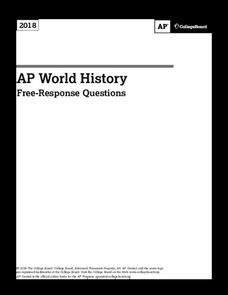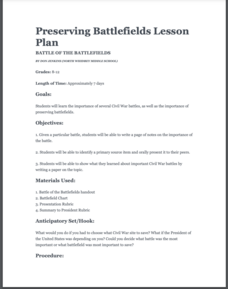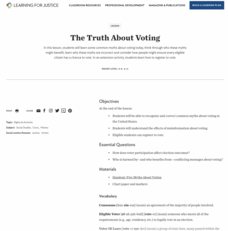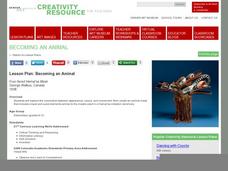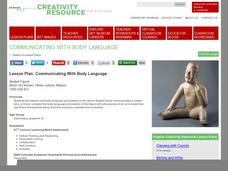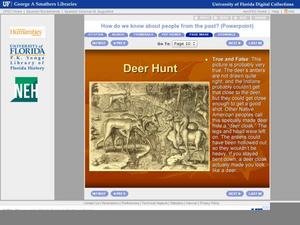College Board
2004 AP® Human Geography Free-Response Questions
Human geography involves everything from why people build factories along the United States-Mexico border to how land-use patterns and demographics are related. So, how do test-takers put it all together? Focused questions from an AP...
College Board
2010 AP® Human Geography Free-Response Questions
Economics and demographics—how are they related? A set of questions from the College Board explore complex ideas such as how the location of raw goods drive the economics of where industries develop and what dynamics weaken or strengthen...
College Board
2018 AP® World History Free-Response Questions
How were the development of railroads critical to the rise of empires? Scholars delve into the relationship between the two using a documents-based question from College Board. Other prompts explore ideas such as nomadic and sedentary...
Advocates for Human Rights
The Right to a Clean Environment: Right to a Clean Environment Role-Play
A lesson plan challenges scholars to think critically about the world in which they live. Learners begin by role-playing a character, answering questions, and taking part in a whole-class discussion. They then brainstorm ways they can...
Constitutional Rights Foundation
The Declaration of Independence
Your class can write a PSA about the Declaration of Independence! They write public service announcements and present them to the class. They also engage in reading and discussion activities to further understand a challenging—yet...
College Board
2009 AP® Microeconomics Free-Response Questions Form B
Two transportation companies must decide the best way to compete. How will that decision affect their prices? Using College Board materials, future test takers examine the problem and think critically to solve it. Other prompts examine...
National WWII Museum
Picturing the War in the Pacific: A Visual Time Line
The Pacific theater was critical to the Allied victory of World War II. Learners deconstruct the sequence of events around the conflict using stunning photographs. After they finish, pupils consider what additional dates and images they...
American Battlefield Trust
Preserving Battlefields
Save that site! Budding historians go on a rescue mission to save important Civil War battle sites using a project-based lesson. After carefully researching the importance of critical engagements and evaluating current threats, learners...
Stanford University
Civil Rights Act of 1964
Was JFK a fallen Civil Rights hero—or a fraud? Learners examine Kennedy's own words and those of his critics to decide for themselves. After examining Kennedy's actions before his assassination, they determine what sort of legacy he left...
Teaching Tolerance
The Truth About Voting
True or False: Only Presidential elections matter. Academics delve into common voting myths to understand what is true and why the election process is critical to democracy. The lesson uses group discussion, activities, and handouts to...
Curated OER
Curriculum Connections with Keiko Kasza
Learners read books by the author Keiko Kasza and complete critical thinking skills, and connections to different subjects. In this language lesson plan, students connect the books to language arts, social studies, science, math, health,...
Curated OER
Components of Civilization
This presentation contains several critical-thinking questions related to the building, components, and purpose of large civilizations. This is an image-driven presentation lacking text. The questions are good so this resource could be...
University of California
Equal Rights? The Women's Movement from Suffrage to Schlafly
If you've never heard of the Equal Rights Amendment, it's probably because there isn't one in the United States Constitution. Delve into the contentious history behind the ERA, its founders and supporters, and reasons for its political...
Curated OER
Lesson Plan: Becoming an Animal
The Kwakwaka'wakw are indigenous people from Vancouver Island and British Columbia. The class analyzes a Kwakwak'wakw ceremonial mask, how it was used, and its cultural significance. They then create animal masks representing their...
Curated OER
Lesson Plan: Carving Through History
Peek into the art and history of ancient Mexico by analyzing the artifact Stone Serpent Heads. Learners examine images of the piece, discuss its origin, history, and significance. They experience the carving process by creating similar...
Curated OER
Lesson Plan: Communicating With Body Language
The Olmec were an ancient people native to Mexico who lived from 1000-500 BC. Young artists examine the Olmec piece Seated Figure to analyze the use of body language to communicate a tone or feeling. They then use clay or play-dough to...
Curated OER
Lesson: Emphasis on Exaggeration
His ears, head, and designs are all an exaggerated form of art. Learners examine a South American sculpture in terms of how exaggeration was used to convey meaning. They then work through the design process as they create similarly...
Curated OER
Lesson Plan: Making History to Go
Learners use their higher-order thinking skills to understand how visual images have been used to tell stories. They analyze a Lakota tipi that tells a story through paint and artistry. They then make miniature tipis using butcher paper...
Curated OER
Lesson: Mixing Metaphors across Current Events and Literature
Expression, current events, and art can go hand-in-hand. After analyzing a multi-media piece entitled, Trade Canoe for Don Quixote, the class explores their own expressive process. They create collages that show a current event or issue...
Curated OER
The Importance of Initiation
The four-faced Hamat'sa mask is the inspiration for a lesson on ceremonial art and the process of initiation. The class examines images of the piece, then discusses how the mask represents ceremonial initiation. They get imaginative when...
Curated OER
Lesson: Creativity on Parade
Parades, ceremonies, and rituals are common to most traditional cultures. Kids analyze a carved piece entitled, Death Cart to understand the significance of these events. They then create floats, carts, and costumes for a class parade...
Curated OER
Lesson: Snake Handling
Are the studies of art and archeology connected? You bet they are! Young scholars research the ancient temples of Mexico by visiting an archaeology site. They describe the various temples they see, taking note of shapes, stairs, details,...
Curated OER
Film Festival: Documentaries for Hispanic Heritage Month
In honor of Hispanic Heritage Month, the New York Times provides links to five short documentary films depicting Hispanic themes and culture. Learners can click on each embedded link to view the films, then answer each set of related...
Curated OER
How Do We Know About People From The Past?
It's not enough to see or just read a primary source document; one has to analyze them fully to understand their historical implications. First learners are introduced to what primary and secondary sources are, then they read a bit of...




